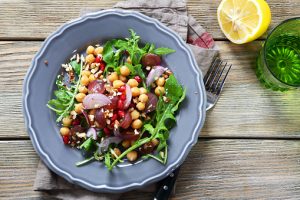 Gout flare-ups can be triggered by food, so knowing what to eat and what to avoid can help you better manage your condition. Gout is a form of arthritis where uric acid crystallizes in small joints – commonly the large toe – causing redness, swelling, and severe pain. Uric acid is the product of the breakdown of purines, which are commonly found in many of the foods we eat. Eating large amounts of purine-rich foods can worsen your gout symptoms.
Gout flare-ups can be triggered by food, so knowing what to eat and what to avoid can help you better manage your condition. Gout is a form of arthritis where uric acid crystallizes in small joints – commonly the large toe – causing redness, swelling, and severe pain. Uric acid is the product of the breakdown of purines, which are commonly found in many of the foods we eat. Eating large amounts of purine-rich foods can worsen your gout symptoms.
If you have gout, you can greatly benefit from following a gout-specific diet, as it can help you lower the rate of flare-ups and gout attacks and help you lose weight. Many gout patients are overweight, which is a risk factor for gout.
Advertisement
The basics of a gout diet include fruits and vegetables, whole grains, and occasional low-fat dairy. Essentially, these are the ingredients to an overall healthy diet that many of us should follow.
Here we will outline a gout diet and help you devise a better way of eating to manage your condition.
What to limit and avoid in a gout diet
As mentioned, foods that contain purines can contribute to gout attacks because of the resulting uric acid accumulation. Therefore, for a proper gout diet, you will want to limit and avoid certain foods, especially those high in purines.
Foods to avoid entirely in a gout diet include seafood, red meat, sugary beverages, and alcohol. Additionally, persons with gout should limit or completely avoid the following as these foods are known to be high in purines, too.
- organ meats
- brain
- sweetbreads
- heart
- kidney
- liver
- beef
- pork
- lamb
- herring
- anchovies
- mackerel
- mussels
- smelt
- sardines
- scallops
- tuna
- yeast
- beer, wine, and liquor
- fruit juices
- soda
Some foods, although containing purines, can still be enjoyed in moderation. These are grouse, mutton, bacon, salmon, turkey, partridge, trout, goose, haddock, and pheasant. If you choose to enjoy these items, you should curb your intake to four to six ounces a day.
Although meat is the primary culprit to gout attacks, patients should also limit their consumption of refined carbohydrates, including white bread, cakes, candy, and pasta – you can consume whole grain pasta, though.
What to include in a gout diet
Now that you are aware of what foods to limit or avoid, here is a list of foods that can easily be enjoyed even if you have gout.
- beans and lentils
- legumes
- fluids, especially water
- low-fat or fat-free dairy (16-24 oz daily)
- whole grains (like oats, brown rice, and barley)
- quinoa
- sweet potatoes
- fruits and vegetables
- spinach
- peas
- asparagus
- cauliflower
- mushrooms
- plant oils
- cherries
- coffee
- water
Not only will these foods reduce your risk of gout attacks, but they can also aid in and promote weight loss, which may be of great help to many gout patients.
Gout-friendly recipes
Finding gout-friendly recipes is fairly easy, considering that now you know which foods you should eat and which ones you should avoid. Some examples of gout-friendly recipes include a refreshing cucumber salad made of chopped cucumber, garlic, low-fat yogurt, and a pinch of salt.
You can enjoy some wholegrain pasta with parmesan cheese, olive oil, garlic, and salt and pepper to taste.
Basically, anything you can think of with the gout-friendly foods you can enjoy easily, so the possibilities are endless!
By sticking to a gout diet, you can better manage your condition and even shed those extra pounds. So the next time you head to the grocery store, keep the above list handy so you know exactly what to reach for.
Related Reading:
Gout-affected men should undergo erectile dysfunction screening: Study
Erectile dysfunction (ED) – impotence – is the inability to get or maintain an erection. There are factors, like alcohol and stress, that can hinder your ability to obtain an erection. But in the case of ED, it is a chronic problem, which may also reveal an underlying health issue. Continue reading…
Advertisement
Rheumatoid arthritis vs. gout, differences in symptoms, causes, and treatment
Rheumatoid arthritis and gout may appear the same because they cause pain, swelling, and stiffness of joints, but there are very distinct differences between the two. Both conditions can lead to disability and impede on your quality of life, but recognizing the differences can help you choose the appropriate course of action in order to best treat your condition. Continue reading…
Sources:
http://guidedoc.com/gout-diet-menu-plan-recipe-diet
http://www.healthline.com/health/gout/diet-restrictions#4
http://www.ukgoutsociety.org/docs/goutsociety-allaboutgoutanddiet-0113.pdf
http://www.mayoclinic.org/healthy-lifestyle/nutrition-and-healthy-eating/in-depth/gout-diet/art-20048524
http://www.arthritis.org/about-arthritis/types/gout/articles/gout-foods.php
http://goutandyou.com/gout-and-grocery-shopping/
